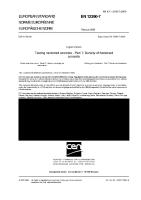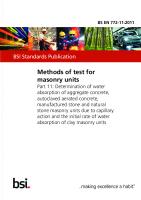Water Absorption, Bulk Density, Apparent Porosity, and Apparent Specific Gravity of Fired Whiteware Products [PDF]
Designation: C373 – 88 (Reapproved 2006) Standard Test Method for Water Absorption, Bulk Density, Apparent Porosity, a
41 0 63KB
Papiere empfehlen
![Water Absorption, Bulk Density, Apparent Porosity, and Apparent Specific Gravity of Fired Whiteware Products [PDF]](https://vdoc.tips/img/200x200/water-absorption-bulk-density-apparent-porosity-and-apparent-specific-gravity-of-fired-whiteware-products.jpg)
- Author / Uploaded
- Jerry Delgado Trujillo
Datei wird geladen, bitte warten...
Zitiervorschau
Designation: C373 – 88 (Reapproved 2006)
Standard Test Method for
Water Absorption, Bulk Density, Apparent Porosity, and Apparent Specific Gravity of Fired Whiteware Products1 This standard is issued under the fixed designation C373; the number immediately following the designation indicates the year of original adoption or, in the case of revision, the year of last revision. A number in parentheses indicates the year of last reapproval. A superscript epsilon (´) indicates an editorial change since the last revision or reapproval.
1. Scope 1.1 This test method covers procedures for determining water absorption, bulk density, apparent porosity, and apparent specific gravity of fired unglazed whiteware products. 1.2 This standard does not purport to address all of the safety concerns, if any, associated with its use. It is the responsibility of the user of this standard to establish appropriate safety and health practices and determine the applicability of regulatory limitations prior to use. 2. Significance and Use 2.1 Measurement of density, porosity, and specific gravity is a tool for determining the degree of maturation of a ceramic body, or for determining structural properties that may be required for a given application. 3. Apparatus and Materials 3.1 Balance, of adequate capacity, suitable to weigh accurately to 0.01 g. 3.2 Oven, capable of maintaining a temperature of 150 6 5°C (302 6 9°F). 3.3 Wire Loop, Halter, or Basket, capable of supporting specimens under water for making suspended mass measurements. 3.4 Container—A glass beaker or similar container of such size and shape that the sample, when suspended from the balance by the wire loop, specified in 3.3, is completely immersed in water with the sample and the wire loop being completely free of contact with any part of the container. 3.5 Pan, in which the specimens may be boiled. 3.6 Distilled Water. 4. Test Specimens 4.1 At least five representative test specimens shall be selected. The specimens shall be unglazed and shall have as much of the surface freshly fractured as is practical. Sharp 1 This test method is under the jurisdiction of ASTM Committee C21 on Ceramic Whitewares and Related Products and is the direct responsibility of Subcommittee C21.03 on Methods for Whitewares and Environmental Concerns. Current edition approved Feb. 15, 2006. Published February 2006. Originally approved in 1955. Last previous edition approved in 1999 as C373 – 88 (1999). DOI: 10.1520/C0373-88R06.
edges or corners shall be removed. The specimens shall contain no cracks. The individual test specimens shall weigh at least 50 g. 5. Procedure 5.1 Dry the test specimens to constant mass (Note 1) by heating in an oven at 150°C (302°F), followed by cooling in a desiccator. Determine the dry mass, D, to the nearest 0.01 g. NOTE 1—The drying of the specimens to constant mass and the determination of their masses may be done either before or after the specimens have been impregnated with water. Usually the dry mass is determined before impregnation. However, if the specimens are friable or evidence indicates that particles have broken loose during the impregnation, the specimens shall be dried and weighed after the suspended mass and the saturated mass have been determined, in accordance with 5.3 and 5.4. In this case, the second dry mass shall be used in all appropriate calculations.
5.2 Place the specimens in a pan of distilled water and boil for 5 h, taking care that the specimens are covered with water at all times. Use setter pins or some similar device to separate the specimens from the bottom and sides of the pan and from each other. After the 5-h boil, allow the specimens to soak for an additional 24 h. 5.3 After impregnation of the test specimens, determine to the nearest 0.01 g the mass, S, of each specimen while suspended in water. Perform the weighing by placing the specimen in a wire loop, halter, or basket that is suspended from one arm of the balance. Before actually weighing, counterbalance the scale with the loop, halter, or basket in place and immerse in water to the same depth as is used when the specimens are in place. If it is desired to determine only the percentage of water absorption, omit the suspended mass operation. 5.4 After the determination of the suspended mass or after impregnation, if the suspended mass is not determined, blot each specimen lightly with a moistened, lint-free linen or cotton cloth to remove all excess water from the surface, and determine the saturated mass, M, to the nearest 0.01 g. Perform the blotting operation by rolling the specimen lightly on the wet cloth, which shall previously have been saturated with water and then pressed only enough to remove such water as will drip from the cloth. Excessive blotting will introduce error
Copyright (C) ASTM International, 100 Barr Harbor Drive, PO Box C-700 West Conshohocken, Pennsylvania 19428-2959, United States
Copyright by ASTM Int'l (all rights reserved); Fri Nov 25 13:40:59 EST 2011 1 Downloaded/printed by Universidad Del Valle pursuant to License Agreement. No further reproductions authorized.
C373 – 88 (2006) by withdrawing water from the pores of the specimen. Make the weighing immediately after blotting, the whole operation being completed as quickly as possible to minimize errors caused by evaporation of water from the specimen. 6. Calculation 6.1 In the following calculations, the assumption is made that 1 cm3 of water weighs 1 g. This is true within about 3 parts in 1000 for water at room temperature. 6.1.1 Calculate the exterior volume, V, in cubic centimetres, as follows: V5M2S
(1)
6.1.2 Calculate the volumes of open pores VOP and impervious portions VIP in cubic centimetres as follows: V OP 5 M 2 D
(2)
VIP 5 D 2 S
(3)
6.1.3 The apparent porosity, P, expresses, as a percent, the relationship of the volume of the open pores of the specimen to its exterior volume. Calculate the apparent porosity as follows: P 5 [~M 2 D!/V# 3 100
(4)
6.1.4 The water absorption, A, expresses as a percent, the relationship of the mass of water absorbed to the mass of the dry specimen. Calculate the water absorption as follows: A 5 [~M 2 D!/D# 3 100
(5)
6.1.5 Calculate the apparent specific gravity, T, of that portion of the test specimen that is impervious to water, as follows: T 5 D/~D 2 S!
(6)
6.1.6 The bulk density, B, in grams per cubic centimetre, of a specimen is the quotient of its dry mass divided by the exterior volume, including pores. Calculate the bulk density as follows: B 5 D/V
(7)
7. Report 7.1 For each property, report the average of the values obtained with at least five specimens, and also the individual values. Where there are pronounced differences among the individual values, test another lot of five specimens and, in addition to individual values, report the average of all ten determinations. 8. Precision and Bias 8.1 This test method is accurate to 60.2 % water absorption in interlaboratory testing when the average value recorded by all laboratories is assumed to be the true water absorption. The precision is approximately 60.1 % water absorption on measurements made by a single experienced operator. 9. Keywords 9.1 apparent porosity; apparent specific gravity; bulk density; fired whiteware products; water absorption
ASTM International takes no position respecting the validity of any patent rights asserted in connection with any item mentioned in this standard. Users of this standard are expressly advised that determination of the validity of any such patent rights, and the risk of infringement of such rights, are entirely their own responsibility. This standard is subject to revision at any time by the responsible technical committee and must be reviewed every five years and if not revised, either reapproved or withdrawn. Your comments are invited either for revision of this standard or for additional standards and should be addressed to ASTM International Headquarters. Your comments will receive careful consideration at a meeting of the responsible technical committee, which you may attend. If you feel that your comments have not received a fair hearing you should make your views known to the ASTM Committee on Standards, at the address shown below. This standard is copyrighted by ASTM International, 100 Barr Harbor Drive, PO Box C700, West Conshohocken, PA 19428-2959, United States. Individual reprints (single or multiple copies) of this standard may be obtained by contacting ASTM at the above address or at 610-832-9585 (phone), 610-832-9555 (fax), or [email protected] (e-mail); or through the ASTM website (www.astm.org).
Copyright by ASTM Int'l (all rights reserved); Fri Nov 25 13:40:59 EST 2011 2 Downloaded/printed by Universidad Del Valle pursuant to License Agreement. No further reproductions authorized.









